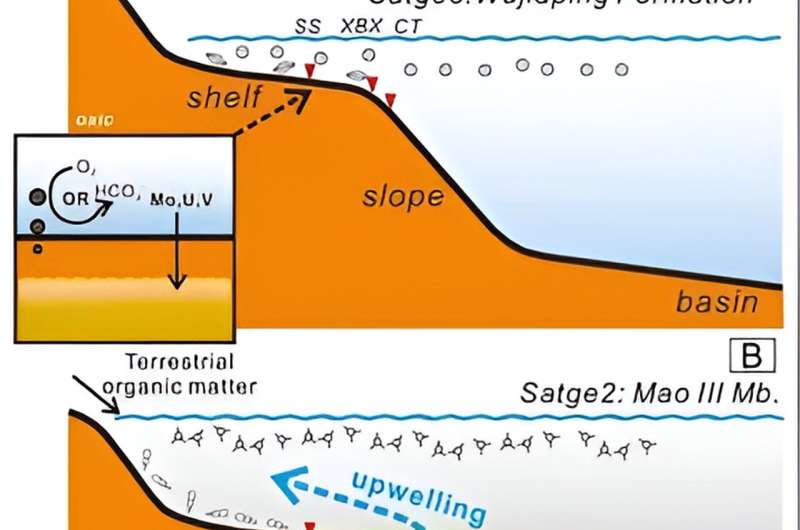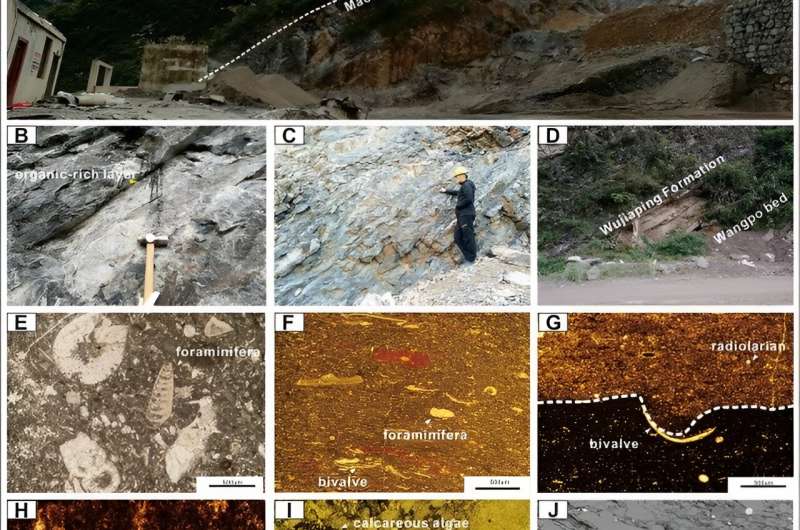December 29, 2023 feature
This article has been reviewed according to Science X's editorial process and policies. Editors have highlighted the following attributes while ensuring the content's credibility:
fact-checked
peer-reviewed publication
trusted source
proofread
Permian marine mass extinction linked to volcanism-induced anoxia

Mass extinctions are rapid global decreases in Earth's biodiversity, with five key events identified over the planet's history, arguably the most famous of which occurred ~66 million years ago during the Cretaceous, which brought the rein of dinosaurs to an end. However, the largest mass extinction is attributed to the Permian, during which it is estimated that >95% of all life on Earth was eradicated.
The cause of this devasting event is still debated, with advocates for both a large asteroid impact that caused dust to plume into the atmosphere, blocking sunlight and generating acid rain, or significant volcanism that released copious amounts of CO2 into the atmosphere and made the oceans toxic to marine life.
New research published in Chemical Geology lends further support to the latter theory. Yu Wang, of Nanjing University, and colleagues conducted geochemical experiments on sediment samples obtained from Zhigao Quarry, in the region of Upper Yangtze River, China. Within the samples, the scientists identified an important mercury anomaly, hosted in organic matter, associated with a peak in carbon isotopes.
This negative carbon-13 isotope excursion is interpreted as being caused by massive releases of carbon into the atmosphere, likely due to volcanic eruptions, and these events are also a major source of mercury in nature. Indeed, the timing of this excursion coincides with known volcanic activity of the Emeishan Traps, Sichuan, a vast area (>250,000 km2) of flood basalts creating a large igneous province.
Trace elements such as molybdenum, uranium and vanadium within the sediment samples are susceptible to reducing and oxidizing conditions, with three noticeable spikes indicative of anoxic conditions when the oceans were depleted in dissolved oxygen. In addition to this, significant global sea level fall during the Capitanian (~264–259 million years ago) is evidenced by terrestrial-derived organic carbon, while lower ratios of the elements cadmium and molybdenum suggest weakened or seasonal upwelling of cold, nutrient-rich waters.
The geochemical data and decline in calcareous algae and fusulinacean foraminifera in the chert, mudstone and limestone samples indicates marine anoxia and more pronounced stratification of the water column. In such conditions, oxygen minimum zones likely developed, with persistent areas of oxygen-poor conditions that would have inhibited the survival of organisms.

The research team propose a three-step volcanic–climatic–oceanic model to explain how the large-scale volcanism led to a biotic crisis in the oceans during the Capitanian leading up to the ultimate end-Permian mass extinction. In stage 1, the study site was part of a carbonate platform that was connected to the Paleo-Tethys Ocean, located along the northern margin of the ancient supercontinent Gondwana. This oxygen-rich shallow marine environment experienced vigorous ocean circulation with upwelling of nutrient-rich waters that were ideal for marine life to thrive, with evidence of algae, brachiopods and corals in the Upper Yangtze sections.
During stage 2, the onset of volcanism began in the early Capitanian, with the significant release of greenhouse gases resulting in climate warming of 3°C–5°C. This coincided with sea level rise caused by regional subsidence, thus exacerbating stratification of the water column and marine anoxia as warmer oceans reduced the concentration of dissolved oxygen. While nutrients were brought to the surface by volcanic activity, primary productivity at the ocean surface used up most of this oxygen for respiration and organic matter decomposition, generating depleted oxygen minimum zones below.
Stage 3 is characterized by a waning of volcanism and a return to shallower marine conditions, with enhanced organic matter transported from land to the ocean, as well as invigorated marine circulation that brought oxic conditions once more. This permitted marine organisms to recover from the hostile anoxic conditions and evolve into new ecological niches.
The scientists arguably suggest we are now in the midst of a sixth mass extinction, and it is vitally important to continue exploring the role volcanism may play in tipping the balance toward another crisis for our marine realm.
More information: Yu Wang et al, Coupled volcanic activity and marine anoxia in the Upper Yangtze region prior to the Capitanian mass extinction, Chemical Geology (2023). DOI: 10.1016/j.chemgeo.2023.121838
Journal information: Chemical Geology
© 2023 Science X Network




















